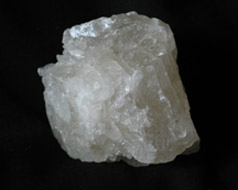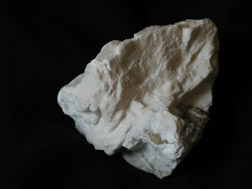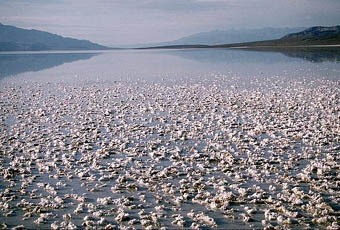Mineral crystals are made as the shallow water that has flooded the bottom of Death Valley evaporates.
Click on image for full size
Courtesy of Martin Miller, University of Oregon
Chemical Sedimentary Rocks
Unlike most other sedimentary rocks, chemical rocks are not made of pieces of sediment. Instead, they have mineral crystals made from elements that are dissolved in water.
The water in the oceans, lakes, and ground is often full of dissolved elements. All sorts of things can dissolve into water. If you put a spoonful of salt into water, the salt will eventually dissolve. Seawater tastes salty mainly because there are salty minerals such as halite dissolved in it.
Sometimes water becomes so full of dissolved elements that they will not all fit. Some are not able to remain dissolved and form solid mineral crystals. This usually happens when some of the water has evaporated away, leaving less room for the dissolved elements. If enough water evaporates, they do not all fit and some form crystals of minerals such as halite, gypsum, and calcite. In the picture to the left, minerals are forming out of shallow water that has flooded the bottom of Death Valley in California. The valley is so hot and dry that water evaporates very quickly, leaving behind the minerals that were once dissolved in it.
Last modified August 25, 2003 by Lisa Gardiner.
You might also be interested in:

Minerals are the building blocks of rocks. They are non-living, solid, and, like all matter, are made of atoms of elements. There are many different types of minerals and each type is made of particular
...more
An element (also called a "chemical element") is a substance made up entirely of atoms having the same atomic number; that is, all of the atoms have the same number of protons. Hydrogen, helium, oxygen,
...more
Everything you see around you is made of tiny particles called atoms. There are many different types of atoms, each with a special combination of protons , neutrons and electrons . These different types
...more
What’s that on your chips? It’s a mineral called halite! If you look closely at ordinary table salt, you will see that, just like other minerals, it looks like crystals. Halite is salt. In its natural
...more
One process which transfers water from the ground back to the atmosphere is evaporation. Evaporation is when water passes from a liquid phase to a gas phase. Rates of evaporation of water depend on things
...more
You can find gypsum in sedimentary rocks, deserts, and caves. Large amounts can form in layers on a salty sea or lake bottom when water evaporates leaving the mineral behind. Gypsum sometimes forms when
...more
Calcite is typically found in the sedimentary rock called limestone. Calcite is also in marble, a metamorphic rock, which forms when limestone is put under strong heat and pressure. Calcite crystals have
...more














